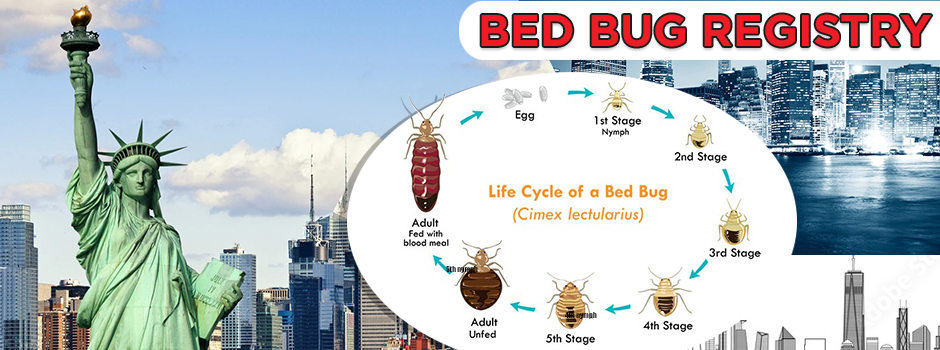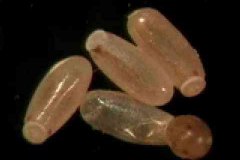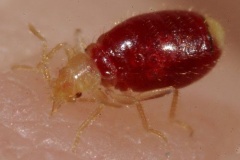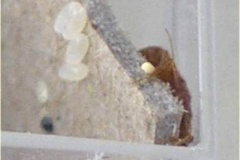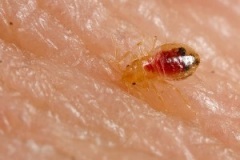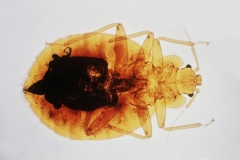(CRAWLING INSECT CONTROL is Perma-Guards EPA approved Diatomaceous Earth used when doing pest control on any type of insect. EPA Reg. No. 73729-1-67197)
(Both Food Grade Diatomaceous Earth and Crawling Insect Control Diatomaceous Earth are 100%Organic.The Crawling Insect ControlDEhas the approved EPA label on it for killing insects.)
Kill Bed Bugs Naturally
Diatomaceous earth Bed Bugsand a couple of plastic applicators (one to sprinkle powder and the other to puff powder) is all you need to get rid of bed bugs organically. No toxic chemicals. No exterminator fees. No need to move out of the house during the process. Full instructions for use ofCRAWLING INSECT CONTROLdiatomaceous earth bed bugs are on this page, and ordering is easy and inexpensive.
NOW IN STOCK BEDBUG INTERCEPTORS JUST PLACE UNDER BED LEGS
To Start: You can start with CRAWLING INSECT CONTROL diatomaceous earth bed bugs , one refillable PD-001 plastic dispenser used to sprinkle the powder ($4.00), and one Pest Pistol Powder Duster to puff the powder into crevices ($8.99).
When transferring theCRAWLING INSECT CONTROL diatomaceous earthfrom the original container, do not try to pour it. Use a large spoon or scoop. Being a fine powder, DE shakes well from the shaker, but does not pour like sand or sugar.
Crawling Insect Control diatomaceous earthwill not only kill the bed bugs you have, but will do it without chemicals. General Application Introduction: Bed bugs cannot fly, so make sure bed is away from the wall and there is no bedding touching the floor.
Surround each of the 4 legs of the bed with CRAWLING INSECT CONTROL diatomaceous earth bed bugs --this will kill them as they try to get on the bed the only way possible. Dismantle bed. Use CRAWLING INSECT CONTROL diatomaceous earthin joints, crevices and where rungs are inserted. See that all interior areas are dusted.
Dust mattressesespecially folds and edges. All cracks and crevices in the bedroom should be treated. Remove electrical outlet covers and puff someCRAWLING INSECT CONTROL diatomaceous earthinside the walls. The "Pest Pistol" works great for this. Keep this routine up for several days until there are no more bed bugs.
"HOW TO" INSTRUCTIONS FOR BED BUG APPLICATION FURTHER DOWN-PAGE.
Remember - Bed bugs are not your fault. You can pick up bed bugs from hotel rooms and infected places and innocently bring bed bugs home. To kill bed bugs naturally andeliminate bed bugs organically use CRAWLING INSECT CONTROL diatomaceous earth bed bugs .
You can spend hundreds of dollars on exterminators to get rid of Bed Bugs with dangerous chemicals and poisons, or you can protect the health of your family and pets with CRAWLING INSECT CONTROL diatomaceous earth bed bugs.
The microscopicCRAWLING INSECT CONTROL diatomaceous earth particles are deadly to the Bed Bug. The particles attach themselves to the bed bugs body and physically "scratch them to death!" Because it kills them mechanically, they cannot become immune to it like they do with so many of the chemicals today. Because it's a mineral, once you put it down it stays there and keeps working. You may sweep it up as you get rid of the dead Bed Bugs, butCRAWLING INSECT CONTROL diatomaceous earthdoesn't loose power over time.
HOW TO APPLY DE TO KILL BED BUGS
Bed Bug Bites
The words "bed bugs" are enough to send most of us running with skin all aquiver at the thought of little blood-sucking creatures crawling all over us as we sleep. These little bugs are pests, to be sure, and they can be difficult to get rid of once they have decided to make your house their home, hiding during the daylight hours in cracks and crevasses where they are almost impossible to excise.
Because of this, you may not realize right away that bed bugs are the source of the annoying sores on your legs when you wake up in the mornings. Bed bugs are attracted by both warmth and the presence of carbon dioxide, which is what we exhale in breathing. The bugs climb up onto your skin and pierce you with two hollow tubes, one of which injects anti-coagulants and anesthetics. The other tube is used to withdraw your blood, feeding for about five minutes before returning to their hiding places.
There may be a cluster of bites instead of singular ones when you awake, and this is typically caused by disturbing the bugs while they feed, causing them to detach and return to feed momentarily. A well fed bedbug can live anywhere from four to six months, while a dormant one might live without feeding for up to 18 months.
The bites can be found just about anywhere on your body, with exposed bits of skin being the preferred feeding ground for the bugs, making your face a target along with arms and legs. The bites cannot be felt at first, but as the anesthetics wear off and the skin begins to react to the injections, the bites can make themselves felt minutes or even hours after the bedbugs have returned to hiding.
If you have bedbugs, your infestation can get worse very quickly since a female bedbug can lay up to five eggs per day, and up to around 500 eggs in her lifetime. Since it takes only five weeks for hatched nymphs to grow to maturity, your problems could expand exponentially within a relatively short period of time, and infestations can be hard to control.
The History of Bed Bugs:
Bed bugs have been around for centuries. Documentation reaching as far back as the 17th century has told about infestations of bed bugs. In the United States, bed bugs were very common until about World War II. With the introduction of such pesticides as DDT, a great decrease in infestations occurred. It was not until the last decade that reported cases gave an indication of a possible rise in bed bug infestations.
Authorities believe that the rise in reports can be attributed to the extermination tactics of pest control today. Today, many pest control experts use baiting tactics for in-home infestations of such things as ants, roaches, and spiders. These baiting tactics work well for their intended subjects, but since bed bugs are blood feeders, they do not fall for the baiting tricks used. This change in exterminating technique has contributed to the rise in reported bed bug infestations.
Identifying a bed bug:
Adult bed bugs are generally flattened and reddish brown in color. They resemble apple seeds in appearance and size. Newly hatched nymphs look very much like adults. Although they are almost colorless, they gain their reddish brown color as they mature. The adult bed bug may lay up to 5 eggs daily. These eggs are almost impossible for humans to see with the naked eye, and resemble a flake of dust on a dark surface.
A quick look at the facts:
Bed bugs are small bloodsucking insects that feed on humans and other warm-blooded animals. Bed Bugs often hide in mattresses but they can also survive in furniture, behind wall coverings and pictures/paintings. They will crawl and nest inside tiny crevices anywhere indoors, as long as there is a source of food (blood).While bed bugs do not transmit any pathogens or diseases, their bites usually result in swollen red, itchy welts. Bed bugs are typically nocturnal insects (they creep about at nighttime).
There are other types of bed bugs including the bat bug, the chimney swift bug and the swallow bug. All of these relatives survive on blood feeding. However these secondary parasites thrive on either bats or birds as their primary victims.
Small reddish or brownish spots on one's linens are often the first sign of an infestation. These spots are the bed bug's droppings. Another sign is swelling where you've been bitten.
Bed bugs are not necessarily a sign of unkempt/dirty homes or buildings.
A female bed bug can lay as many as 500 eggs during her lifetime.
Bed bugs are less than 1/4 inch in length, flat, and oval-shaped like; a bit like a sunflower seed.
Bed bugs can go up to a year without a blood meal.
A bed bug's saliva features an anesthetic to numb the pain as it's biting. It also contains anti-coagulant to keep the blood of its meal host flowing.
Furniture that is inspected should be inspected thoroughly. Remove "pull out" drawers and inspect any and all small creases and openings.
Taking apart furniture is often advised if you want to get at the source of the bed bug infestation. Doing this in a garage or outdoors is preferred, if possible.
The covering on the bottom of a box spring bed should be taken off for inspection and treatment measures. If the infestation is severe, you may want to dispose of the mattress.
Bed bugs are many times also found underneath the edges of carpets, where ceilings and walls meet, behind light switch covers and outlets, in clothes, inside appliances, and behind baseboards and carpet stays.
Itching:
There are a number of things you can do to stop the itching.
Bed bug dangers:
When a bed bug bites, it injects an anti-blood clotting chemical into the skin. Some people may actually be allergic to bed bugs, and the degree of itching is determined by how allergic a person is. If you notice any signs of infection, call your physician IMMEDIATELY. Scratching the bites can also result in an infection. If you do not get an infection, the bites are simply an irritating nuisance. It may take a few weeks for the itching to subside and for the welts to disappear. BED BUGS DO NOT CARRY PATHOGENS as mosquitoes or ticks do!
Diatomaceous Earth FAQ: http://www.earthworkshealth.com/Diatomaceous-Earth-FAQ.php
PERMA-GUARD CRAWLING INSECT CONTROL---EPA REGISTERED AND APPROVED! EPA REG. NO. 73729-1-67197 EPA ESTABLISHMENT NO. 67197-UT-001
Read the original:
Diatomaceous Earth Bed Bugs

 Residence
Residence  Location
Location 
